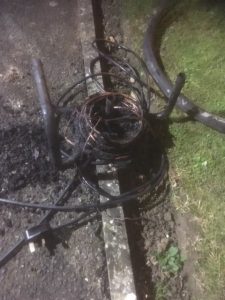 We add advice from Electrical Safety First to an urgent safety warning issued by firefighters after an extension lead overheated, starting a house fire in Hamstreet, near Ashford last night (Tuesday, 7 November).
We add advice from Electrical Safety First to an urgent safety warning issued by firefighters after an extension lead overheated, starting a house fire in Hamstreet, near Ashford last night (Tuesday, 7 November).
The blaze was discovered by a neighbour just before 8pm who heard the smoke alarms sounding and went into the house. The occupant was not home at the time so the neighbour attempted to put the fire out, taking in smoke in the process.
Three fire engines were sent to the end-of-terrace property and arrived to find smoke billowing from the rear of the house. They gave the neighbour oxygen therapy before handing him into the care of an-off duty paramedic for precautionary checks.
Ashford Watch Manager, Kevin Surridge said: “A breathing apparatus team found a coiled up extension reel that was run to a tumble drier in a first-floor rear bedroom, had sparked the blaze.”
Firefighters made sure the fire was completely out and cleared smoke and fumes from the property using a special fan.
Kevin added: “As the weather cools down, we start to use more electrical appliances around our homes, but my advice would be to only use them when you are there, never leave them running while you’re asleep or away from your home.”
With Christmas next month, homeowners will soon be thinking about decorating their homes with lights and are asked to please keep safety in mind – don’t overload sockets, use circuit breakers and make sure extension leads are fully unwound to prevent overheating.
Kevin ended: “Just because there might be space to plug in four appliances on an extension lead, it doesn’t mean it’s always safe to do so. Make sure your home and family are safe from the devastating effects of fire this winter by having working smoke alarms and testing them regularly.”
The fire damage was limited to the room of origin, but caused extensive heat and smoke damage to the first floor.
If you have any concerns about keeping yourself or a friend or relative safe, get in touch with Kent Fire and Rescue Service by email or phone.
Kent Fire and Rescue Service 8 November 2017
www.kent.fire-uk.org/news/news-releases/november-2017/extension-lead-sparks-fire-in-hamstreet-home/
Electrical Safety First Advice regarding extension leads and heaters
Extensions and cables
The more wall sockets you have in your home the less you will need an extension cable or adapter. However, many portable electrical items like lamps and radios are supplied with relatively short cables. So sometimes it is unavoidable not to have to use one, but beware of the following dangers.
- Damaged cable, due to leads being walked over, continually bent at the same point or stored badly.
- You can trip or fall over taut, over-stretched cable.
- Leads on power tools frequently become tangled, leading to one of the conductors eventually failing – this could cause danger.
- Overuse of multi-way adapters or adapter blocks, which increases the risk of fire
An extension lead should only be used when it is not possible to reach a wall socket with the equipment cable. When the use of an extension cable is unavoidable – follow these simple suggestions:
- Only use an extension lead which was bought ready-assembled.
- We recommend that no extension lead be more than 15 metres long.
- Only use extension leads fitted with suitably insulated connectors and plugs. (Never join two lengths of flexible cable by twisting the bare ends of wires together.)
- Position an extension lead carefully to prevent any risk of damage.
- If the cable has to cross a pathway, cover it with a rubber protector strip.
- Always check that leads, plugs and sockets are undamaged.
- Always check the extension lead plug contains the correctly rated fuse for the equipment being used.
- If using a cable drum extension lead, it should be completely unwound to avoid overheating.
- For general use, 2-core extension leads should not be used.
www.electricalsafetyfirst.org.uk/guides-and-advice/around-the-home/extensions-and-leads/
Electric heaters
- Never leave portable heaters unattended
- Never leave them on whilst sleeping
- Ensure that they are positioned well away from anything which could knock them over
- Ensure they are at least a metre away from any combustible materials, such as paper or curtains
- Never buy second hand halogen heaters
- Never power a halogen heater from an extension lead – these can easily be overloaded and cause fires
- Regularly inspect your heater for damage. If it’s damaged, don’t use it
www.electricalsafetyfirst.org.uk/media-centre/press-releases/2014/11/playing-with-fire-consumers-are-risking-lives-by-using-portable-heaters-incorrectly/
 Speed and stopping distances don’t increase at the same rate. Small increases in speed result in bigger increases in stopping distances.
Speed and stopping distances don’t increase at the same rate. Small increases in speed result in bigger increases in stopping distances.




 We add advice from Electrical Safety First to an urgent safety warning issued by firefighters after an extension lead overheated, starting a house fire in Hamstreet, near Ashford last night (Tuesday, 7 November).
We add advice from Electrical Safety First to an urgent safety warning issued by firefighters after an extension lead overheated, starting a house fire in Hamstreet, near Ashford last night (Tuesday, 7 November). Remember to follow safety and security advice if you are taking part in Halloween activities this weekend:
Remember to follow safety and security advice if you are taking part in Halloween activities this weekend: 
